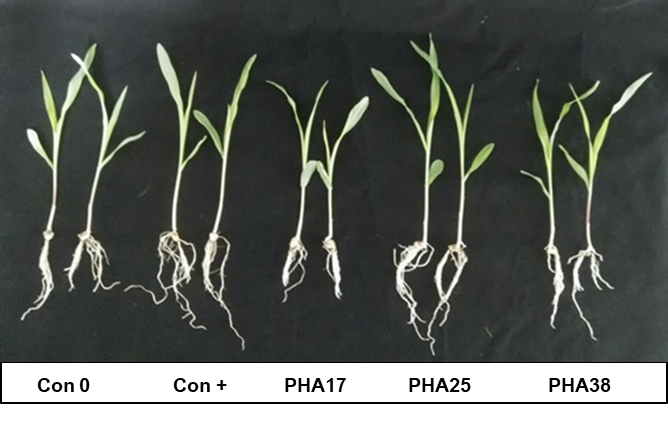Effect of phosphate solubilizing bacteria from rhizosphere soil of Phaseolus lathyroides L. on growth waxy corn
Keywords:
Phosphate solubilizing bacteria, Plant growth promoting rhizobacteria, Chlorophyll content, Phosphorus concentrationAbstract
This study aimed to isolate the phosphate solubilizing bacteria (PSB) from rhizosphere of Phaseolus lathyroides L. and to study the effect of PSB on waxy corn growth. Thirty-nine isolates of rhizosphere bacteria were obtained from P. lathyroides and 12.82% (n = 5) of them able to solubilize phosphate on PVK agar. The phosphate solubilization efficiency presented in the range of 1.07 ± 0.17 to 1.41 ± 0.19, isolate PHA25 showed the highest phosphate solubilizing efficiency followed by PHA38 PHA17 PHA31 and PHA3, respectively. Then, the growth characteristics of waxy corn were evaluated after the seeds were soaked in PSB suspension of PHA17 PHA25 and PHA38. After 7 days of planting, isolate PHA25 significantly promoted the growth of waxy corn including root fresh weight and longest root length compared to untreated control at P<0.05; moreover, it increased root fresh weight, shoot length, longest root length and total root length for 13.33 10.24 47.5 and 33.99%, respectively. For chlorophyll content in the waxy corn leaf at 28 days, isolate PHA38 significantly (P<0.01) stimulated the highest photosynthesis for 40.79 and 30.67% compared to untreated control and adding chemical fertilizer, respectively. However, the highest of phosphorus concentration in whole shoot of waxy corn was highest in adding chemical fertilizer treatment, followed by soaking in PHA38 suspension which was increased for 56.25% compared to untreated control.
References
Backer R, Rokem JS, Ilangumaran G, Lamont J, Praslickova D, Ricci E, et al. Plant growth-promoting rhizobacteria: context, mechanisms of action, and roadmap to commercialization of biostimulants for sustainable agriculture. Front. Plant Sci. 2018; 9:1473. doi:10.3389/ fpls.2018.01473.
Dharmanitivedya S. Plant growth promoting rhizobacteria: principles and utilization. Naresuan Agri. J. [Internet]. 2021 [cited 15 July 23021]; 18: e0180109. Available from: https://li01.tci-thaijo.org/index.php/aginujournal/article/view/248047/171717.
Baber M, Fatima M, Abbas R, Qaisrani MM, Naz S, Hanif MK, et al. Weed rhizosphere: a source of novel plant growth promoting rhizobacteria (PGPR). Int. J. Biosci. 2018; 13(1): 224-234.
Vayuparp K. Enhancing productivity of waxy corn. Bangkok: Department of Agriculture; 2558. Field and Renewable Energy Crops Research Institute.
Seo Y, Park K, Chang E, Ryu S, Park J and Kim K. Effect of salicylic acid and abscisic acid on drought stress of waxy corn. Korean J. Crop Sci. 2014; 59(1): 54–58.
Varukonda SSKP, Vardharajula S, Shrivastava M, and SkZ A. Enhancement of drought stress tolerance in crops by plant growth promoting rhizobacteria. Microbiol Res. 2016; 184: 13-24.
Travlos IS and Chachalis D. Drought adaptation strategies of weeds and other neglected plants of arid environments. Plant Stress. 2008; 2(1): 40-44.
Noda K, Teerawatsakul M, Prakongvongs C and Chaiwiratnukul L. Major weeds in Thailand. 3rd ed. Bangkok: Mass & Media Co. LTD.; 1994; 164 p.
Sundara Rao WVB and Sinha MK. Phosphate dissolving microorganisms in the soil and rhizosphere. Indian J. Agr. Sci. 1963; 33: 272-278.
Zhao K, Penttinen P, Zhang X, Ao X, Liu M, Yu X, et al. Maize rhizosphere in Sichuan, China, hosts plant growth promoting Burkholderia cepacia with phosphate solubilizing and antifungal abilities. Microbiol. Res. 2014; 169: 76-82.
Junrungreang S, Rossopa B and Sajjaphan K. Effect of phosphate-solubilizing bacteria, Burkholderia sp. strain Rs01, on growth of Insee2 sweet corn. Kamphaengsean Acad. J. 2010; 8(1): 1-14.
Shafi J, Tian H and Ji M. Bacillus species as versatile weapons for plant pathogens: a review. Biotechnol. Biotechnol. Equip. 2017; 31(3): 446–459.
Paul D and Shinha SN. Isolation and characterization of phosphate solubilizing bacterium Pseudomonas aeruginosa KUPSB12 with antibacterial potential from river Ganga, India. Ann. Agric. Sci. 2017; 15(1): 130–136.
Saengsanga T. PGPR: The role in promoting and protecting plant under stress conditions. Thai Sci. Tech. J. 2014; 22(4): 553-570.
Detta C. and Basu P. Indole acetic acid production by a Rhizobium species from root nodules of a leguminous shrub Cajanus cajan. Microbiol. Res. 2000; 155: 123-127.
Wimat N, Pinjai P and Jittamart N. Phosphorus availability in soil and sugarcane growth by phosphate solubilizing bacteria. 2020; 38(4): 477-488.
Marasco R, Rolli E, Vigani G, Borin S, Sorlini C, Ouzari H, et al. Are drought-resistance promoting bacteria cross-compatible with different plant models?. Plant Signal Behav. 2013; 8(10): e26741. https://doi:10.4161/psb.26741.
Varukonda SSKP, Vardharajula S, Shrivastava M, and SkZ A. Multifunctional Pseudomonas putida strain FBKV2 from arid rhizosphere soil and its growth promotional effects on maize under drought stress. Rhizosphere. 2016; 1: 4-13.

Downloads
Published
How to Cite
Issue
Section
License
Copyright (c) 2022 Naresuan Phayao Journal

This work is licensed under a Creative Commons Attribution-NonCommercial-NoDerivatives 4.0 International License.
ผู้นิพนธ์ต้องรับผิดชอบข้อความในบทนิพนธ์ของตน มหาวิทยาลัยพะเยาไม่จำเป็นต้องเห็นด้วยกับบทความที่ตีพิมพ์เสมอไป ผู้สนใจสามารถคัดลอก และนำไปใช้ได้ แต่จะต้องขออนุมัติเจ้าของ และได้รับการอนุมัติเป็นลายลักษณ์อักษรก่อน พร้อมกับมีการอ้างอิงและกล่าวคำขอบคุณให้ถูกต้องด้วย
The authors are themselves responsible for their contents. Signed articles may not always reflect the opinion of University of Phayao. The articles can be reproduced and reprinted, provided that permission is given by the authors and acknowledgement must be given.







